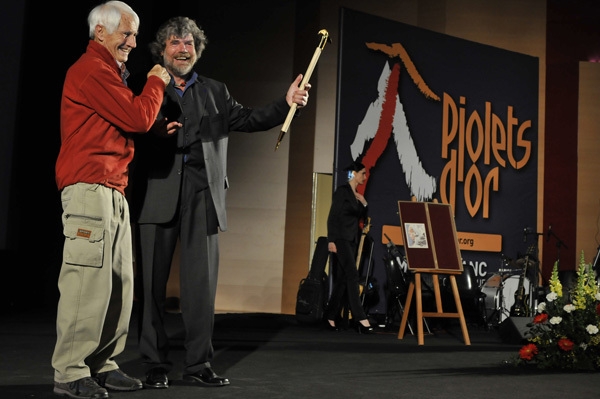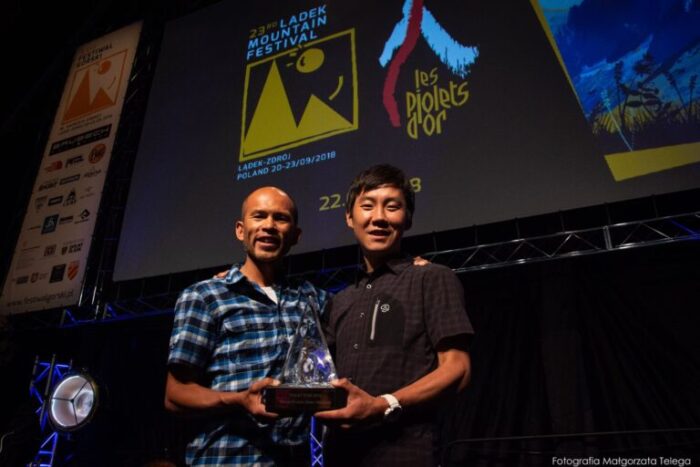The 2024 edition of the Piolets d’Or awards is taking place over the next few days in San Martino di Castrozza in the Italian Dolomites. Organized by the Group de Haute Montagne, a Piolet d’Or been the most prestigious recognition in mountaineering since the awards began in 1992. Piolet d’Or is French for “Golden Ice Axe.”
The Piolets d’Or originally promoted French alpinism and awarded a single climb as the best of the previous year. Since then, it has evolved to be more international. A crisis in 2007-08 caused by the aversion of many climbers to competition prompted a rethinking.
Now, several climbs are recognized each year for their excellence. The committee also introduced a Lifetime Achievement award. The first recipient was Walter Bonatti, and the second was Reinhold Messner. This year, it will go to Jordi Corominas of Spain.
The latest addition is a special mention for female mountaineering, given this year to Nives Meroi of Italy.

Walter Bonatti gives Reinhold Messner the Piolet d’Or for Life Achievement. Photo: Pascal Tournaire
At ExplorersWeb, when we introduce a climber as a Piolet d’Or recipient, it implies that this person is a highly skilled alpinist with an impressive record of alpine-style climbs. Alpine style signifies a particularly pure form of climbing, where small teams attempt difficult goals in a minimalist way.
Who judges these awards, and what criteria do they use?
What makes a ‘good’ climb?
Social media boasts enthusiastic claims of mountaineering “records” and “historic feats.” Yet publicly celebrated climbers like Nirmal Purja and Kristin Harila, the two fastest to climb all 14 8,000m peaks, were not even nominated for their achievements. Nor have extreme athletes with unquestioned skills and worldwide fame, such as Kilian Jornet. Meanwhile, Paul Ramsden of the UK holds a record five Piolets d’Or but is little known beyond the community of hard-core alpinists.

Paul Ramsden climbs the Phantom Line on Jugal Spire in 2022, his latest Piolet d’Or-winning project. Photo: Tim Collins
This year, three teams will receive one of these coveted Piolets d’Or:
- Americans Matt Cornell, Jackson Marvell, and Alan Rousseau for a new route on the North Face of Mount Jannu in Nepal’s Kangchenjunga region.
- Hugo Beguin, Matthias Gribi, and Nathan Monard of Switzerland for a new route on a 6,000m peak in the Indian Himalaya.
- Kazuya Hiraide and Kenro Nakajima of Japan will receive theirs posthumously for the first ascent in 2023 of the North Face of Tirich Mir in Pakistan. It will be the fourth Piolet d’Or for Hiraide and the third for Nakajima. Sadly, both perished earlier this year while trying to open a new alpine-style route on the West Face of K2. True to a pure mountaineering style, they were attempting this bold new line on the world’s second-highest peak without previously fixed ropes or camps, in a single push from base to summit, just two men alone on unknown terrain.
“The awards aim to celebrate commitment, the taste for adventure, and the sense of exploration,” the organizers state on the Piolet d’Or website. The summit matters less than how the climbers attempt to reach it.
Sending a message
According to the organizers, the goal is not merely to award the best climbs.
“The purpose [is] to use these ascents to promote clear ethical messages regarding our practices as alpinists around the world, in line with the UNESCO classification of alpinism as an intangible cultural heritage,” the Piolets d’Or organizers state.
Each year features many remarkable climbs from around the world. Previously, the jury came out with a shortlist, then chose two or three award winners from them. Recently, they have decided to highlight all significant ascents. This year, the list includes over 50 expeditions. In an environment as variable as the mountains, picking two or three among these seems anything but easy.
Their criteria include style, level of commitment and self-sufficiency, the spirit of exploration, and the technical ability required, among others. The jury also factors in respect for other climbers, local communities, and the environment, as well as how the teams try to minimize resources.
Not everyone happy
Not everyone in the mountaineering community loves the Piolets d’Or. Some climbers dislike the whole idea that one climb is somehow better than another and refuse to accept an award if given; others ask the jury not to nominate them.
The committee tries to avoid the flavor of winners and losers and instead promotes a collective celebration of excellence in alpinism. That is why the selected climbs are announced in advance. However, the awards are still a great distinction, and of course, the climbers’ sponsors love them.

Kazuya Hiraide, left, and Kenro Nakajima with a Piolet d’Or in 2018. Photo: Magorzata Telega
One source of debate among wider audiences is how far we should encourage high-risk alpinism. It is hardly a coincidence that over a dozen former Piolet d’Or winners have later died in the mountains. In 2024 alone, the organizers will pay tribute to Hiraide, Nakajima, and three more: Russians Dmitry Golovchenko and Sergey Nilov, and Archil Badriashvili of Georgia. All perished while climbing in the last two years.
Marek Holecek has two Piolets d’Or in his career. Last month, he climbed the terrible east face of Langtang Lirung, ordinarily a sure awards candidate for 2025. But Holecek’s partner, Ondrej Husherka, died in a crevasse fall during the descent, which eliminates the climb, excellent though it was, from Piolet d’Or contention. Some years ago, a Russian expedition received a Piolet d’Or, despite losing two members. A controversy erupted, and since then, the jury only awards climbs in which everyone survived.






